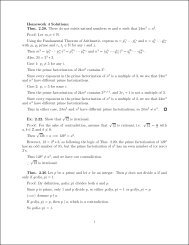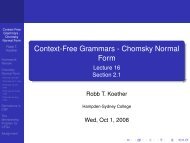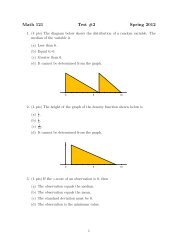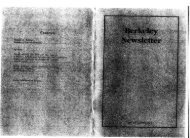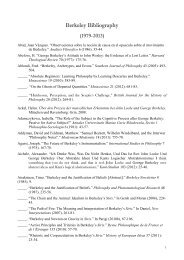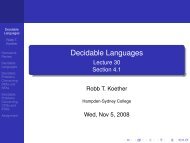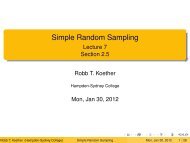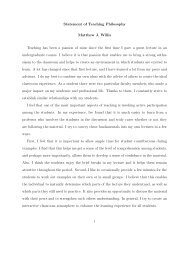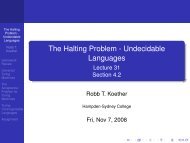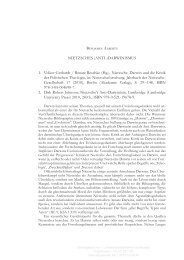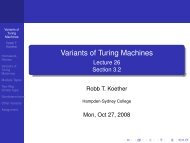Pushdown Automata - Hampden-Sydney College
Pushdown Automata - Hampden-Sydney College
Pushdown Automata - Hampden-Sydney College
You also want an ePaper? Increase the reach of your titles
YUMPU automatically turns print PDFs into web optimized ePapers that Google loves.
<strong>Pushdown</strong><br />
<strong>Automata</strong> -<br />
Equivalence<br />
to CFGs<br />
Robb T.<br />
Koether<br />
Homework<br />
Review<br />
Equivalence<br />
of PDAs and<br />
CFGs<br />
Proof ⇒<br />
Proof ⇐<br />
Long Example<br />
Short<br />
Example<br />
Assignment<br />
<strong>Pushdown</strong> <strong>Automata</strong> - Equivalence to CFGs<br />
Lecture 19<br />
Section 2.2<br />
Robb T. Koether<br />
<strong>Hampden</strong>-<strong>Sydney</strong> <strong>College</strong><br />
Wed, Oct 8, 2008
Outline<br />
<strong>Pushdown</strong><br />
<strong>Automata</strong> -<br />
Equivalence<br />
to CFGs<br />
Robb T.<br />
Koether<br />
Homework<br />
Review<br />
Equivalence<br />
of PDAs and<br />
CFGs<br />
Proof ⇒<br />
Proof ⇐<br />
Long Example<br />
Short<br />
Example<br />
Assignment<br />
1 Homework Review<br />
2 Equivalence of PDAs and CFGs<br />
Proof ⇒<br />
Proof ⇐<br />
3 Long Example<br />
4 Short Example<br />
5 Assignment
Homework Review<br />
<strong>Pushdown</strong><br />
<strong>Automata</strong> -<br />
Equivalence<br />
to CFGs<br />
Robb T.<br />
Koether<br />
Homework<br />
Review<br />
Equivalence<br />
of PDAs and<br />
CFGs<br />
Proof ⇒<br />
Proof ⇐<br />
Long Example<br />
Exercise<br />
Let Σ = {a, (, ), [, ]}. Design a PDA whose language is<br />
{w | w contains balanced parentheses and brackets}.<br />
Short<br />
Example<br />
Assignment
Homework Review<br />
<strong>Pushdown</strong><br />
<strong>Automata</strong> -<br />
Equivalence<br />
to CFGs<br />
Robb T.<br />
Koether<br />
Homework<br />
Review<br />
Equivalence<br />
of PDAs and<br />
CFGs<br />
Proof ⇒<br />
Proof ⇐<br />
Long Example<br />
Short<br />
Example<br />
Assignment<br />
Solution<br />
The a’s can be placed anywhere.<br />
A ( or a [ can be read anywhere, but ( must eventually<br />
be balanced by ) and [ must eventually be balanced by<br />
].<br />
Use the stack to assure that the parentheses and<br />
brackets are properly matched.
Homework Review<br />
<strong>Pushdown</strong><br />
<strong>Automata</strong> -<br />
Equivalence<br />
to CFGs<br />
Robb T.<br />
Koether<br />
Solution<br />
Homework<br />
Review<br />
Equivalence<br />
of PDAs and<br />
CFGs<br />
Proof ⇒<br />
Proof ⇐<br />
Long Example<br />
Short<br />
Example<br />
Assignment<br />
a, ε → ε<br />
(, ε → (<br />
[, ε → [<br />
), ( → ε<br />
], [ → ε<br />
ε, ε → $ ε, $ → ε
Equivalence of PDAs and CFGs<br />
<strong>Pushdown</strong><br />
<strong>Automata</strong> -<br />
Equivalence<br />
to CFGs<br />
Robb T.<br />
Koether<br />
Homework<br />
Review<br />
Equivalence<br />
of PDAs and<br />
CFGs<br />
Proof ⇒<br />
Proof ⇐<br />
Long Example<br />
Theorem (Equivalence of PDAs and CFGs)<br />
A language is context-free if and only if it is accepted by<br />
some PDA.<br />
Short<br />
Example<br />
Assignment
Equivalence of PDAs and CFGs<br />
<strong>Pushdown</strong><br />
<strong>Automata</strong> -<br />
Equivalence<br />
to CFGs<br />
Robb T.<br />
Koether<br />
Homework<br />
Review<br />
Equivalence<br />
of PDAs and<br />
CFGs<br />
Proof ⇒<br />
Proof ⇐<br />
Long Example<br />
Short<br />
Example<br />
Proof (⇒).<br />
We are given a CFG G and we will construct a PDA M.<br />
Let M have four states:<br />
Q = {q 0 , q 1 , q 2 , q 3 }.<br />
q 0 is the start state.<br />
q 3 is the accept state.<br />
Assignment
Equivalence of PDAs and CFGs<br />
<strong>Pushdown</strong><br />
<strong>Automata</strong> -<br />
Equivalence<br />
to CFGs<br />
Robb T.<br />
Koether<br />
Homework<br />
Review<br />
Equivalence<br />
of PDAs and<br />
CFGs<br />
Proof ⇒<br />
Proof ⇐<br />
Long Example<br />
Short<br />
Example<br />
Assignment<br />
Proof (⇒).<br />
The transitions are<br />
δ(q 0 , ε, ε) = {(q 1 , $)}<br />
δ(q 1 , ε, ε) = {(q 2 , S)}<br />
δ(q 2 , ε, A) = {(q 2 , w)}, where A → w is a rule.<br />
δ(q 2 , a, a) = {(q 2 , ε)}, for all a ∈ Σ.<br />
δ(q 2 , ε, $) = {(q 3 , ε)}<br />
It is clear that L(M) = L(G).
Equivalence of PDAs and CFGs<br />
<strong>Pushdown</strong><br />
<strong>Automata</strong> -<br />
Equivalence<br />
to CFGs<br />
Robb T.<br />
Koether<br />
Proof (⇒).<br />
Homework<br />
Review<br />
Equivalence<br />
of PDAs and<br />
CFGs<br />
Proof ⇒<br />
Proof ⇐<br />
Long Example<br />
Short<br />
Example<br />
Assignment<br />
ε, ε → $<br />
A, ε → w<br />
a, a → ε<br />
ε, ε → S ε, $ → ε
Equivalence of PDAs and CFGs<br />
<strong>Pushdown</strong><br />
<strong>Automata</strong> -<br />
Equivalence<br />
to CFGs<br />
Robb T.<br />
Koether<br />
Homework<br />
Review<br />
Equivalence<br />
of PDAs and<br />
CFGs<br />
Proof ⇒<br />
Proof ⇐<br />
Long Example<br />
Short<br />
Example<br />
Assignment<br />
Proof (⇐).<br />
Given a PDA M, we must construct a grammar G that<br />
generates L(M).<br />
Modify M so that<br />
M has a single accept state.<br />
M empties its stack before accepting.<br />
Each transition either pushes one symbol or pops one<br />
symbol, but not both.
The Variables<br />
<strong>Pushdown</strong><br />
<strong>Automata</strong> -<br />
Equivalence<br />
to CFGs<br />
Robb T.<br />
Koether<br />
Homework<br />
Review<br />
Equivalence<br />
of PDAs and<br />
CFGs<br />
Proof ⇒<br />
Proof ⇐<br />
Long Example<br />
Short<br />
Example<br />
Assignment<br />
Proof (⇐).<br />
For every pair of states p and q in M, we create a<br />
variable A pq .<br />
The variable A pq is interpreted to mean<br />
“Get from state p with an empty stack to state q with an<br />
empty stack.”<br />
Since the stack starts and ends empty, we must push a<br />
symbol at the beginning and pop a symbol at the end.
The Grammar Rules<br />
<strong>Pushdown</strong><br />
<strong>Automata</strong> -<br />
Equivalence<br />
to CFGs<br />
Robb T.<br />
Koether<br />
Homework<br />
Review<br />
Equivalence<br />
of PDAs and<br />
CFGs<br />
Proof ⇒<br />
Proof ⇐<br />
Long Example<br />
Short<br />
Example<br />
Proof (⇐).<br />
There are two possibilities in going from p to q.<br />
The first symbol pushed does not match the last symbol<br />
popped.<br />
The first symbol pushed matches the last symbol<br />
popped.<br />
Assignment
The Grammar Rules<br />
<strong>Pushdown</strong><br />
<strong>Automata</strong> -<br />
Equivalence<br />
to CFGs<br />
Robb T.<br />
Koether<br />
Homework<br />
Review<br />
Equivalence<br />
of PDAs and<br />
CFGs<br />
Proof ⇒<br />
Proof ⇐<br />
Long Example<br />
Short<br />
Example<br />
Assignment<br />
Proof (⇐).<br />
For the rules in Group 1, use all pairs of transitions<br />
where the first transition pushes a symbol and the<br />
second transition pops a symbol, whether or not they<br />
are the same symbol.<br />
For each such pair of transitions δ(p, a, ε) = (s, c) and<br />
δ(t, b, d) = (q, ε), write the rules<br />
A pq → A pr A rq<br />
for all intermediate states r ∈ Q.
The Grammar Rules<br />
<strong>Pushdown</strong><br />
<strong>Automata</strong> -<br />
Equivalence<br />
to CFGs<br />
Robb T.<br />
Koether<br />
Homework<br />
Review<br />
Equivalence<br />
of PDAs and<br />
CFGs<br />
Proof ⇒<br />
Proof ⇐<br />
Long Example<br />
Proof (⇐).<br />
The Group 1 rules allow us to break the processing up<br />
into segments that begin and end with an empty stack,<br />
but during which the stack is never empty.<br />
Short<br />
Example<br />
Assignment
The Grammar Rules<br />
<strong>Pushdown</strong><br />
<strong>Automata</strong> -<br />
Equivalence<br />
to CFGs<br />
Robb T.<br />
Koether<br />
Homework<br />
Review<br />
Equivalence<br />
of PDAs and<br />
CFGs<br />
Proof ⇒<br />
Proof ⇐<br />
Long Example<br />
Proof (⇐).<br />
Stack<br />
depth<br />
x, ε → a<br />
x, y → ε<br />
x, ε → z<br />
x, b → ε<br />
Short<br />
Example<br />
Assignment<br />
p<br />
r<br />
q<br />
State
The Grammar Rules<br />
<strong>Pushdown</strong><br />
<strong>Automata</strong> -<br />
Equivalence<br />
to CFGs<br />
Robb T.<br />
Koether<br />
Homework<br />
Review<br />
Equivalence<br />
of PDAs and<br />
CFGs<br />
Proof ⇒<br />
Proof ⇐<br />
Long Example<br />
Short<br />
Example<br />
Assignment<br />
Proof (⇐), continued.<br />
For the rules in Group 2, use all pairs of transitions<br />
where the second transition pops the same symbol that<br />
the first transition pushes.<br />
For each such pair of transitions δ(p, a, ε) = (r, c) and<br />
δ(s, b, c) = (q, ε), write the rule<br />
A pq → aA rs b.
The Grammar Rules<br />
<strong>Pushdown</strong><br />
<strong>Automata</strong> -<br />
Equivalence<br />
to CFGs<br />
Robb T.<br />
Koether<br />
Homework<br />
Review<br />
Equivalence<br />
of PDAs and<br />
CFGs<br />
Proof ⇒<br />
Proof ⇐<br />
Long Example<br />
Proof (⇐).<br />
Stack<br />
depth<br />
a, ε → c b, c → ε<br />
Short<br />
Example<br />
Assignment<br />
p<br />
r<br />
s<br />
q<br />
State
The Grammar Rules<br />
<strong>Pushdown</strong><br />
<strong>Automata</strong> -<br />
Equivalence<br />
to CFGs<br />
Robb T.<br />
Koether<br />
Homework<br />
Review<br />
Equivalence<br />
of PDAs and<br />
CFGs<br />
Proof ⇒<br />
Proof ⇐<br />
Long Example<br />
Proof (⇐).<br />
Stack<br />
depth<br />
a, ε → c b, c → ε<br />
Short<br />
Example<br />
Assignment<br />
p<br />
r<br />
s<br />
q<br />
State
The Grammar Rules<br />
<strong>Pushdown</strong><br />
<strong>Automata</strong> -<br />
Equivalence<br />
to CFGs<br />
Robb T.<br />
Koether<br />
Homework<br />
Review<br />
Equivalence<br />
of PDAs and<br />
CFGs<br />
Proof ⇒<br />
Proof ⇐<br />
Long Example<br />
Short<br />
Example<br />
Proof (⇐), continued.<br />
Finally, the Group 3 rules are of the form<br />
A pp → ε<br />
for every state p.<br />
Assignment
The Start Symbol<br />
<strong>Pushdown</strong><br />
<strong>Automata</strong> -<br />
Equivalence<br />
to CFGs<br />
Robb T.<br />
Koether<br />
Homework<br />
Review<br />
Equivalence<br />
of PDAs and<br />
CFGs<br />
Proof ⇒<br />
Proof ⇐<br />
Long Example<br />
Short<br />
Example<br />
Assignment<br />
Proof (⇐), conclusion.<br />
Let q start be the start state and q accept be the accept<br />
state.<br />
Then the start symbol is A qstart q accept<br />
.<br />
If we can eventually replace the start symbol with all<br />
terminals, then the string of terminals must be in the<br />
language.<br />
Therefore, L(G) = L(M).
Example<br />
<strong>Pushdown</strong><br />
<strong>Automata</strong> -<br />
Equivalence<br />
to CFGs<br />
Robb T.<br />
Koether<br />
Homework<br />
Review<br />
Example (Convert a PDA to a CFG)<br />
Find a grammar for the following PDA.<br />
Equivalence<br />
of PDAs and<br />
CFGs<br />
Proof ⇒<br />
Proof ⇐<br />
Long Example<br />
Short<br />
Example<br />
Assignment<br />
p<br />
a, ε → a<br />
ε, ε → $<br />
q<br />
ε, $ → ε<br />
b, a → ε<br />
r
Example<br />
<strong>Pushdown</strong><br />
<strong>Automata</strong> -<br />
Equivalence<br />
to CFGs<br />
Robb T.<br />
Koether<br />
Homework<br />
Review<br />
Equivalence<br />
of PDAs and<br />
CFGs<br />
Proof ⇒<br />
Proof ⇐<br />
Long Example<br />
Example (Convert a PDA to a CFG)<br />
The variables are A pp , A pq , A pr , A qp , A qq , A qr , A rp , A rq ,<br />
and A rr .<br />
Short<br />
Example<br />
Assignment
The Grammar Rules (Group 1)<br />
<strong>Pushdown</strong><br />
<strong>Automata</strong> -<br />
Equivalence<br />
to CFGs<br />
Robb T.<br />
Koether<br />
Homework<br />
Review<br />
Equivalence<br />
of PDAs and<br />
CFGs<br />
Proof ⇒<br />
Proof ⇐<br />
Long Example<br />
Short<br />
Example<br />
Example (Convert a PDA to a CFG)<br />
Then we get the Group 1 grammar rules, based on the<br />
transitions.<br />
δ(p, ε, ε) = (q, $)<br />
δ(q, a, ε) = (q, a)<br />
δ(q, b, a) = (q, ε)<br />
δ(q, ε, $) = (r, ε)<br />
Assignment
The Grammar Rules (Group 1)<br />
<strong>Pushdown</strong><br />
<strong>Automata</strong> -<br />
Equivalence<br />
to CFGs<br />
Robb T.<br />
Koether<br />
Homework<br />
Review<br />
Equivalence<br />
of PDAs and<br />
CFGs<br />
Proof ⇒<br />
Proof ⇐<br />
Long Example<br />
Short<br />
Example<br />
Assignment<br />
Example (Convert a PDA to a CFG)<br />
Find all pairs of transitions where<br />
The first transition pushes a symbol x.<br />
The second transition pops a symbol y.<br />
The rules:<br />
δ(p, ε, ε) = (q, $)<br />
δ(q, a, ε) = (q, a)<br />
δ(q, b, a) = (q, ε)<br />
δ(q, ε, $) = (r, ε)
The Grammar Rules (Group 1)<br />
<strong>Pushdown</strong><br />
<strong>Automata</strong> -<br />
Equivalence<br />
to CFGs<br />
Robb T.<br />
Koether<br />
Homework<br />
Review<br />
Equivalence<br />
of PDAs and<br />
CFGs<br />
Proof ⇒<br />
Proof ⇐<br />
Long Example<br />
Short<br />
Example<br />
Assignment<br />
Example (Convert a PDA to a CFG)<br />
The pair<br />
δ(p, ε, ε) = (q, $)<br />
δ(q, b, a) = (q, ε)<br />
gives the rules A pq → A px A xq for all x ∈ Q.<br />
That is,<br />
A pq → A pp A pq<br />
A pq → A pq A qq<br />
A pq → A pr A rq
The Grammar Rules (Group 1)<br />
<strong>Pushdown</strong><br />
<strong>Automata</strong> -<br />
Equivalence<br />
to CFGs<br />
Robb T.<br />
Koether<br />
Homework<br />
Review<br />
Equivalence<br />
of PDAs and<br />
CFGs<br />
Proof ⇒<br />
Proof ⇐<br />
Long Example<br />
Short<br />
Example<br />
Assignment<br />
Example (Convert a PDA to a CFG)<br />
The pair<br />
δ(p, ε, ε) = (q, $)<br />
δ(q, ε, $) = (r, ε)<br />
gives the rules A pr → A px A xr for all x ∈ Q.<br />
That is,<br />
A pr → A pp A pr<br />
A pr → A pq A qr<br />
A pr → A pr A rr
The Grammar Rules (Group 1)<br />
<strong>Pushdown</strong><br />
<strong>Automata</strong> -<br />
Equivalence<br />
to CFGs<br />
Robb T.<br />
Koether<br />
Homework<br />
Review<br />
Equivalence<br />
of PDAs and<br />
CFGs<br />
Proof ⇒<br />
Proof ⇐<br />
Long Example<br />
Short<br />
Example<br />
Assignment<br />
Example (Convert a PDA to a CFG)<br />
The pair<br />
δ(q, a, ε) = (q, a)<br />
δ(q, b, a) = (q, ε)<br />
gives the rules A qq → A qx A xq for all x ∈ Q.<br />
That is,<br />
A qq → A qp A pq<br />
A qq → A qq A qq<br />
A qq → A qr A rq
The Grammar Rules (Group 1)<br />
<strong>Pushdown</strong><br />
<strong>Automata</strong> -<br />
Equivalence<br />
to CFGs<br />
Robb T.<br />
Koether<br />
Homework<br />
Review<br />
Equivalence<br />
of PDAs and<br />
CFGs<br />
Proof ⇒<br />
Proof ⇐<br />
Long Example<br />
Short<br />
Example<br />
Assignment<br />
Example (Convert a PDA to a CFG)<br />
The pair<br />
δ(q, a, ε) = (q, a)<br />
δ(q, ε, $) = (r, ε)<br />
gives the rules A qr → A qx A xr for all x ∈ Q.<br />
That is,<br />
A qr → A qp A pr<br />
A qr → A qq A qr<br />
A qr → A qr A rr
The Grammar Rules (Group 1)<br />
<strong>Pushdown</strong><br />
<strong>Automata</strong> -<br />
Equivalence<br />
to CFGs<br />
Robb T.<br />
Koether<br />
Homework<br />
Review<br />
Equivalence<br />
of PDAs and<br />
CFGs<br />
Proof ⇒<br />
Proof ⇐<br />
Long Example<br />
Short<br />
Example<br />
Assignment<br />
Example (Convert a PDA to a CFG)<br />
We get the first group of rules.<br />
A pq → A pp A pq A qq → A qp A pq<br />
A pq → A pq A qq A qq → A qq A qq<br />
A pq → A pr A rq A qq → A qr A rq<br />
A pr → A pp A pr A qr → A qp A pr<br />
A pr → A pq A qr A qr → A qq A qr<br />
A pr → A pr A rr A qr → A qr A rr
The Grammar Rules (Group 1)<br />
<strong>Pushdown</strong><br />
<strong>Automata</strong> -<br />
Equivalence<br />
to CFGs<br />
Robb T.<br />
Koether<br />
Homework<br />
Review<br />
Equivalence<br />
of PDAs and<br />
CFGs<br />
Proof ⇒<br />
Proof ⇐<br />
Long Example<br />
Short<br />
Example<br />
Assignment<br />
Example (Convert a PDA to a CFG)<br />
We may eliminate all rules with variables that represent<br />
impossible situations.<br />
A pq → A pp A pq A qq → A qp A pq<br />
A pq → A pq A qq A qq → A qq A qq<br />
A pq → A pr A rq A qq → A qr A rq<br />
A pr → A pp A pr A qr → A qp A pr<br />
A pr → A pq A qr A qr → A qq A qr<br />
A pr → A pr A rr A qr → A qr A rr
The Grammar Rules (Group 1)<br />
<strong>Pushdown</strong><br />
<strong>Automata</strong> -<br />
Equivalence<br />
to CFGs<br />
Robb T.<br />
Koether<br />
Homework<br />
Review<br />
Equivalence<br />
of PDAs and<br />
CFGs<br />
Proof ⇒<br />
Proof ⇐<br />
Long Example<br />
Short<br />
Example<br />
Assignment<br />
Example (Convert a PDA to a CFG)<br />
The Group 1 rules are<br />
A pq → A pp A pq<br />
A pq → A pq A qq<br />
A pr → A pp A pr<br />
A pr → A pq A qr<br />
A pr → A pr A rr<br />
A qq → A qq A qq<br />
A qr → A qq A qr<br />
A qr → A qr A rr
The Grammar Rules (Group 2)<br />
<strong>Pushdown</strong><br />
<strong>Automata</strong> -<br />
Equivalence<br />
to CFGs<br />
Robb T.<br />
Koether<br />
Homework<br />
Review<br />
Equivalence<br />
of PDAs and<br />
CFGs<br />
Proof ⇒<br />
Proof ⇐<br />
Long Example<br />
Short<br />
Example<br />
Example (Convert a PDA to a CFG)<br />
Then we get the Group 2 grammar rules, based on the<br />
transitions.<br />
δ(p, ε, ε) = (q, $)<br />
δ(q, a, ε) = (q, a)<br />
δ(q, b, a) = (q, ε)<br />
δ(q, ε, $) = (r, ε)<br />
Assignment
The Grammar Rules (Group 2)<br />
<strong>Pushdown</strong><br />
<strong>Automata</strong> -<br />
Equivalence<br />
to CFGs<br />
Robb T.<br />
Koether<br />
Homework<br />
Review<br />
Equivalence<br />
of PDAs and<br />
CFGs<br />
Proof ⇒<br />
Proof ⇐<br />
Long Example<br />
Short<br />
Example<br />
Assignment<br />
Example (Convert a PDA to a CFG)<br />
For every stack symbol s and for every pair of<br />
transitions, one of which pushes s and the other of<br />
which pops s, we write a grammar rule<br />
A xy → aA zw b<br />
where a is the symbol read when s is pushed and b is<br />
the symbol read when s is popped.
The Grammar Rules (Group 2)<br />
<strong>Pushdown</strong><br />
<strong>Automata</strong> -<br />
Equivalence<br />
to CFGs<br />
Robb T.<br />
Koether<br />
Homework<br />
Review<br />
Equivalence<br />
of PDAs and<br />
CFGs<br />
Proof ⇒<br />
Proof ⇐<br />
Long Example<br />
Short<br />
Example<br />
Example (Convert a PDA to a CFG)<br />
The pair<br />
δ(p, ε, ε) = (q, $)<br />
δ(q, ε, $) = (r, ε)<br />
gives the rule<br />
A pr → εA qq ε = A qq<br />
Assignment
The Grammar Rules (Group 2)<br />
<strong>Pushdown</strong><br />
<strong>Automata</strong> -<br />
Equivalence<br />
to CFGs<br />
Robb T.<br />
Koether<br />
Homework<br />
Review<br />
Equivalence<br />
of PDAs and<br />
CFGs<br />
Proof ⇒<br />
Proof ⇐<br />
Long Example<br />
Short<br />
Example<br />
Example (Convert a PDA to a CFG)<br />
The pair<br />
δ(p, ε, ε) = (q, $)<br />
δ(q, ε, $) = (r, ε)<br />
gives the rule<br />
A pr → εA qq ε = A qq<br />
Assignment
The Grammar Rules (Group 2)<br />
<strong>Pushdown</strong><br />
<strong>Automata</strong> -<br />
Equivalence<br />
to CFGs<br />
Robb T.<br />
Koether<br />
Homework<br />
Review<br />
Equivalence<br />
of PDAs and<br />
CFGs<br />
Proof ⇒<br />
Proof ⇐<br />
Long Example<br />
Short<br />
Example<br />
Example (Convert a PDA to a CFG)<br />
The pair<br />
δ(p, ε, ε) = (q, $)<br />
δ(q, ε, $) = (r, ε)<br />
gives the rule<br />
A pr → εA qq ε = A qq<br />
Assignment
The Grammar Rules (Group 2)<br />
<strong>Pushdown</strong><br />
<strong>Automata</strong> -<br />
Equivalence<br />
to CFGs<br />
Robb T.<br />
Koether<br />
Homework<br />
Review<br />
Equivalence<br />
of PDAs and<br />
CFGs<br />
Proof ⇒<br />
Proof ⇐<br />
Long Example<br />
Short<br />
Example<br />
Example (Convert a PDA to a CFG)<br />
The pair<br />
δ(p, ε, ε) = (q, $)<br />
δ(q, ε, $) = (r, ε)<br />
gives the rule<br />
A pr → εA qq ε = A qq<br />
Assignment
The Grammar Rules (Group 2)<br />
<strong>Pushdown</strong><br />
<strong>Automata</strong> -<br />
Equivalence<br />
to CFGs<br />
Robb T.<br />
Koether<br />
Homework<br />
Review<br />
Equivalence<br />
of PDAs and<br />
CFGs<br />
Proof ⇒<br />
Proof ⇐<br />
Long Example<br />
Short<br />
Example<br />
Example (Convert a PDA to a CFG)<br />
The pair<br />
δ(p, ε, ε) = (q, $)<br />
δ(q, ε, $) = (r, ε)<br />
gives the rule<br />
A pr → εA qq ε = A qq<br />
Assignment
The Grammar Rules (Group 2)<br />
<strong>Pushdown</strong><br />
<strong>Automata</strong> -<br />
Equivalence<br />
to CFGs<br />
Robb T.<br />
Koether<br />
Homework<br />
Review<br />
Equivalence<br />
of PDAs and<br />
CFGs<br />
Proof ⇒<br />
Proof ⇐<br />
Long Example<br />
Short<br />
Example<br />
Example (Convert a PDA to a CFG)<br />
The pair<br />
δ(q, a, ε) = (q, a)<br />
δ(q, b, a) = (q, ε)<br />
gives the rule<br />
A qq → aA qq b<br />
Assignment
The Grammar Rules (Group 2)<br />
<strong>Pushdown</strong><br />
<strong>Automata</strong> -<br />
Equivalence<br />
to CFGs<br />
Robb T.<br />
Koether<br />
Homework<br />
Review<br />
Equivalence<br />
of PDAs and<br />
CFGs<br />
Proof ⇒<br />
Proof ⇐<br />
Long Example<br />
Short<br />
Example<br />
Example (Convert a PDA to a CFG)<br />
The pair<br />
δ(q, a, ε) = (q, a)<br />
δ(q, b, a) = (q, ε)<br />
gives the rule<br />
A qq → aA qq b<br />
Assignment
The Grammar Rules (Group 2)<br />
<strong>Pushdown</strong><br />
<strong>Automata</strong> -<br />
Equivalence<br />
to CFGs<br />
Robb T.<br />
Koether<br />
Homework<br />
Review<br />
Equivalence<br />
of PDAs and<br />
CFGs<br />
Proof ⇒<br />
Proof ⇐<br />
Long Example<br />
Short<br />
Example<br />
Example (Convert a PDA to a CFG)<br />
The pair<br />
δ(q, a, ε) = (q, a)<br />
δ(q, b, a) = (q, ε)<br />
gives the rule<br />
A qq → aA qq b<br />
Assignment
The Grammar Rules (Group 2)<br />
<strong>Pushdown</strong><br />
<strong>Automata</strong> -<br />
Equivalence<br />
to CFGs<br />
Robb T.<br />
Koether<br />
Homework<br />
Review<br />
Equivalence<br />
of PDAs and<br />
CFGs<br />
Proof ⇒<br />
Proof ⇐<br />
Long Example<br />
Short<br />
Example<br />
Example (Convert a PDA to a CFG)<br />
The pair<br />
δ(q, a, ε) = (q, a)<br />
δ(q, b, a) = (q, ε)<br />
gives the rule<br />
A qq → aA qq b<br />
Assignment
The Grammar Rules (Group 2)<br />
<strong>Pushdown</strong><br />
<strong>Automata</strong> -<br />
Equivalence<br />
to CFGs<br />
Robb T.<br />
Koether<br />
Homework<br />
Review<br />
Equivalence<br />
of PDAs and<br />
CFGs<br />
Proof ⇒<br />
Proof ⇐<br />
Long Example<br />
Short<br />
Example<br />
Example (Convert a PDA to a CFG)<br />
The pair<br />
δ(q, a, ε) = (q, a)<br />
δ(q, b, a) = (q, ε)<br />
gives the rule<br />
A qq → aA qq b<br />
Assignment
The Grammar Rules (Group 2)<br />
<strong>Pushdown</strong><br />
<strong>Automata</strong> -<br />
Equivalence<br />
to CFGs<br />
Robb T.<br />
Koether<br />
Homework<br />
Review<br />
Equivalence<br />
of PDAs and<br />
CFGs<br />
Proof ⇒<br />
Proof ⇐<br />
Long Example<br />
Example (Convert a PDA to a CFG)<br />
The Group 2 rules are<br />
A pr → A qq<br />
A qq → aA qq b<br />
Short<br />
Example<br />
Assignment
The Grammar Rules (Group 3)<br />
<strong>Pushdown</strong><br />
<strong>Automata</strong> -<br />
Equivalence<br />
to CFGs<br />
Robb T.<br />
Koether<br />
Homework<br />
Review<br />
Equivalence<br />
of PDAs and<br />
CFGs<br />
Proof ⇒<br />
Proof ⇐<br />
Long Example<br />
Short<br />
Example<br />
Example (Convert a PDA to a CFG)<br />
Finally, the Group 3 rules are<br />
A pp → ε<br />
A qq → ε<br />
A rr → ε<br />
Assignment
The Grammar Rules<br />
<strong>Pushdown</strong><br />
<strong>Automata</strong> -<br />
Equivalence<br />
to CFGs<br />
Robb T.<br />
Koether<br />
Homework<br />
Review<br />
Equivalence<br />
of PDAs and<br />
CFGs<br />
Proof ⇒<br />
Proof ⇐<br />
Long Example<br />
Short<br />
Example<br />
Assignment<br />
Example (Convert a PDA to a CFG)<br />
This gives us the grammar rules<br />
A pq → A pp A pq<br />
A pq → A pq A qq<br />
A pr → A pp A pr<br />
A pr → A pq A qr<br />
A pr → A pr A rr<br />
A qq → A qq A qq<br />
A qr → A qq A qr<br />
A qr → A qr A rr<br />
A pr → A qq<br />
A qq → aA qq b<br />
A pp → ε<br />
A qq → ε<br />
A rr → ε
The Grammar<br />
<strong>Pushdown</strong><br />
<strong>Automata</strong> -<br />
Equivalence<br />
to CFGs<br />
Robb T.<br />
Koether<br />
Homework<br />
Review<br />
Equivalence<br />
of PDAs and<br />
CFGs<br />
Proof ⇒<br />
Proof ⇐<br />
Example (Convert a PDA to a CFG)<br />
The start symbol is A pr .<br />
Long Example<br />
Short<br />
Example<br />
Assignment
The Grammar<br />
<strong>Pushdown</strong><br />
<strong>Automata</strong> -<br />
Equivalence<br />
to CFGs<br />
Robb T.<br />
Koether<br />
Homework<br />
Review<br />
Equivalence<br />
of PDAs and<br />
CFGs<br />
Proof ⇒<br />
Proof ⇐<br />
Long Example<br />
Short<br />
Example<br />
Assignment<br />
Example (Convert a PDA to a CFG)<br />
The complete grammar is<br />
A pr → A pp A pr | A pq A qr | A pr A rr | A qq<br />
A pp → ε<br />
A pq → A pp A pq | A pq A qq<br />
A qq → aA qq b | A qq A qq | ε<br />
A qr → A qq A qr | A qr A rr<br />
A rr → ε.
Example<br />
<strong>Pushdown</strong><br />
<strong>Automata</strong> -<br />
Equivalence<br />
to CFGs<br />
Robb T.<br />
Koether<br />
Homework<br />
Review<br />
Equivalence<br />
of PDAs and<br />
CFGs<br />
Proof ⇒<br />
Proof ⇐<br />
Long Example<br />
Short<br />
Example<br />
Example (Convert a PDA to a CFG)<br />
Find a grammar for the language of the following PDA.<br />
(, ε → ( ), ( → ε<br />
ε, ε → $<br />
a, ε → ε<br />
ε, $ → ε<br />
+, ε → ε<br />
Assignment
Example<br />
<strong>Pushdown</strong><br />
<strong>Automata</strong> -<br />
Equivalence<br />
to CFGs<br />
Robb T.<br />
Koether<br />
Homework<br />
Review<br />
Equivalence<br />
of PDAs and<br />
CFGs<br />
Proof ⇒<br />
Proof ⇐<br />
Long Example<br />
Short<br />
Example<br />
Assignment<br />
Example (Convert a PDA to a CFG)<br />
First, we need to modify the PDA:<br />
(, ε → (<br />
), ( → ε<br />
a, ε → ( r ε, ( → ε<br />
ε, ε → $<br />
ε, $ → ε<br />
p<br />
q<br />
s<br />
ε, ( → ε t +, ε → (<br />
u
Example<br />
<strong>Pushdown</strong><br />
<strong>Automata</strong> -<br />
Equivalence<br />
to CFGs<br />
Robb T.<br />
Koether<br />
Homework<br />
Review<br />
Equivalence<br />
of PDAs and<br />
CFGs<br />
Proof ⇒<br />
Proof ⇐<br />
Long Example<br />
Short<br />
Example<br />
Assignment<br />
Example (Convert a PDA to a CFG)<br />
The transitions are<br />
Pushes<br />
Pops<br />
δ(p, ε, ε) = (q, $) δ(r, ε, () = (s, ε)<br />
δ(q, (, ε) = (q, () δ(s, ), () = (s, ε)<br />
δ(q, a, ε) = (r, () δ(t, ε, () = (q, ε)<br />
δ(s, +, ε) = (t, () δ(s, ε, $) = (u, ε)
Group 1 Rules<br />
<strong>Pushdown</strong><br />
<strong>Automata</strong> -<br />
Equivalence<br />
to CFGs<br />
Robb T.<br />
Koether<br />
Homework<br />
Review<br />
Equivalence<br />
of PDAs and<br />
CFGs<br />
Proof ⇒<br />
Proof ⇐<br />
Long Example<br />
Short<br />
Example<br />
Assignment<br />
Example (Convert a PDA to a CFG)<br />
For the Group 1 rules, there are 16 combinations of a<br />
transition that pushes with a transition that pops.<br />
However, there are only three beginning states {p, q, s}<br />
and three ending states {s, q, u}.<br />
So there are only 9 sets of rules:<br />
A ps → A px A xs for all x ∈ Q<br />
A pq → A px A xq for all x ∈ Q<br />
A pu → A px A xu for all x ∈ Q<br />
A qs → A qx A xs for all x ∈ Q<br />
A qq → A qx A xq for all x ∈ Q<br />
A qu → A qx A xu for all x ∈ Q<br />
A ss → A sx A xs for all x ∈ Q<br />
A sq → A sx A xq for all x ∈ Q<br />
A su → A sx A xu for all x ∈ Q
Group 1 Rules<br />
<strong>Pushdown</strong><br />
<strong>Automata</strong> -<br />
Equivalence<br />
to CFGs<br />
Robb T.<br />
Koether<br />
Homework<br />
Review<br />
Equivalence<br />
of PDAs and<br />
CFGs<br />
Proof ⇒<br />
Proof ⇐<br />
Long Example<br />
Short<br />
Example<br />
Assignment<br />
Example (Convert a PDA to a CFG)<br />
That gives 54 rules.<br />
We can eliminate the ones containing variables of the<br />
form A xp for x ≠ p and A ux for x ≠ u.<br />
That eliminates 12 rules, leaving 42.<br />
A ps → A px A xs for all x ∈ Q, x ≠ u<br />
A pq → A px A xq for all x ∈ Q, x ≠ u<br />
A pu → A px A xu for all x ∈ Q<br />
A qs → A qx A xs for all x ∈ Q, x ≠ p, u<br />
A qq → A qx A xq for all x ∈ Q, x ≠ p, u<br />
A qu → A qx A xu for all x ∈ Q, x ≠ p<br />
A ss → A sx A xs for all x ∈ Q, x ≠ p, u<br />
A sq → A sx A xq for all x ∈ Q, x ≠ p, u<br />
A su → A sx A xu for all x ∈ Q, x ≠ p
Group 2 Rules<br />
<strong>Pushdown</strong><br />
<strong>Automata</strong> -<br />
Equivalence<br />
to CFGs<br />
Robb T.<br />
Koether<br />
Homework<br />
Review<br />
Equivalence<br />
of PDAs and<br />
CFGs<br />
Proof ⇒<br />
Proof ⇐<br />
Long Example<br />
Short<br />
Example<br />
Assignment<br />
Example (Convert a PDA to a CFG)<br />
There is 1 combination of transitions that pushes and<br />
pops $.<br />
There are 9 combinations of transitions that push and<br />
pop (.<br />
So there are 10 rules in Group 2.<br />
A pu → A qs<br />
A qs → (A qr<br />
A qs → (A qs )<br />
A qq → (A qt<br />
A qs → aA rr<br />
A qs → aA rs )<br />
A qq → aA rt<br />
A ss → +A tr<br />
A ss → +A ts )<br />
A sq → +A tt
Group 3 Rules<br />
<strong>Pushdown</strong><br />
<strong>Automata</strong> -<br />
Equivalence<br />
to CFGs<br />
Robb T.<br />
Koether<br />
Homework<br />
Review<br />
Equivalence<br />
of PDAs and<br />
CFGs<br />
Proof ⇒<br />
Proof ⇐<br />
Long Example<br />
Short<br />
Example<br />
Assignment<br />
Example (Convert a PDA to a CFG)<br />
There are 6 rules in Group 3.<br />
A pp → ε<br />
A qq → ε<br />
A rr → ε<br />
A ss → ε<br />
A tt → ε<br />
A uu → ε
Assignment<br />
<strong>Pushdown</strong><br />
<strong>Automata</strong> -<br />
Equivalence<br />
to CFGs<br />
Robb T.<br />
Koether<br />
Homework<br />
Review<br />
Equivalence<br />
of PDAs and<br />
CFGs<br />
Proof ⇒<br />
Proof ⇐<br />
Long Example<br />
Short<br />
Example<br />
Assignment<br />
Homework<br />
Read Section 2.2, pages 115 - 123.<br />
Exercises 11, 12, page 129.<br />
Find a grammar for the language<br />
L = {w | w contains an equal number of a’s and b’s}<br />
with PDA<br />
a, ε → a<br />
a, b → ε<br />
b, a → ε b, ε → b<br />
a > b<br />
a, ε → $ b, ε → $<br />
b. $ → ε<br />
a. $ → ε<br />
a < b



